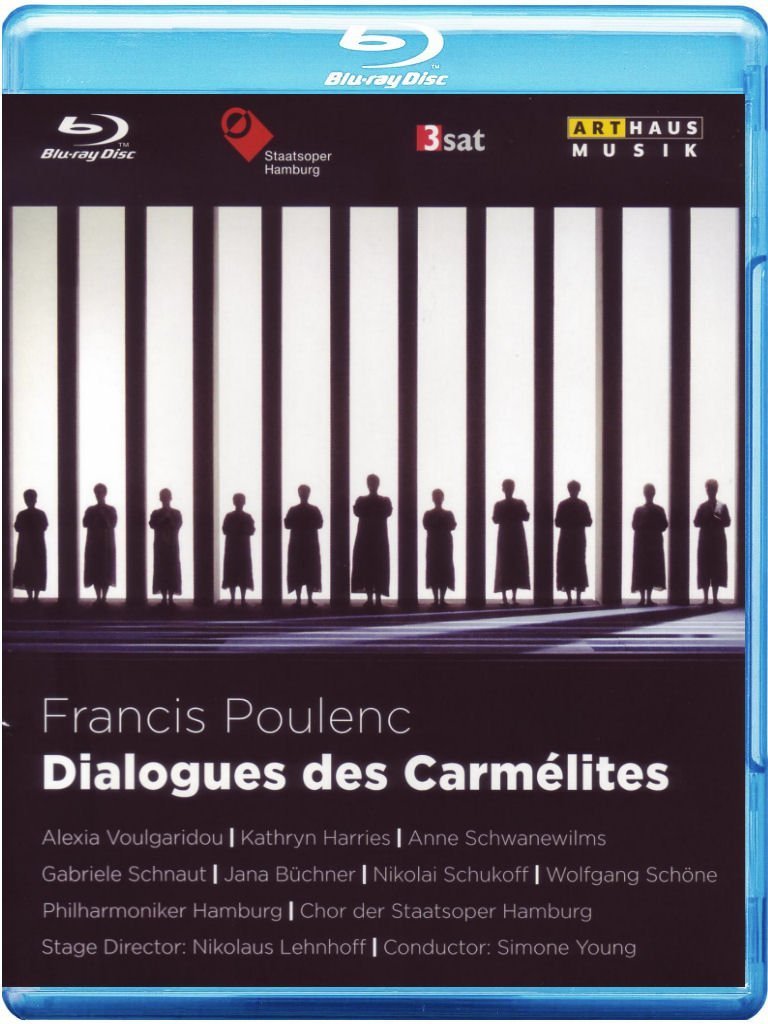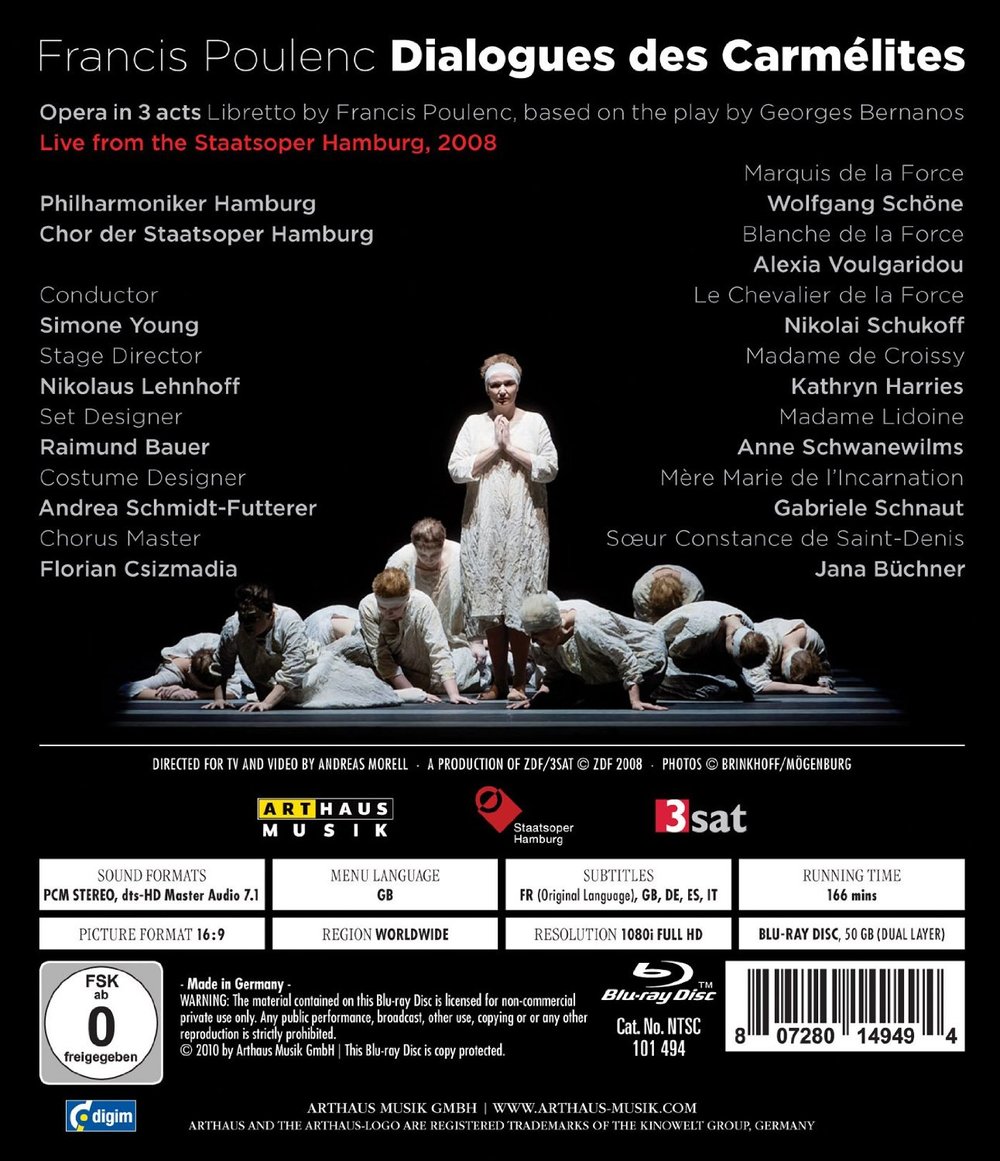

Francis Poulenc Dialogues des carmélites opera to libretto by the composer based on the play by Georges Bernanos. Directed 2008 by Nikolaus Lehnhoff at the Staatsoper Hamburg. Stars Wolfgang Schöne (Marquis de la Force), Alexia Voulgaridou (Blanche de la Force), Nikolai Schukoff (Le Chevalier de la Force), Kathryn Harries (Madame de Croissy), Anne Schwanewilms (Madame Lidoine), Gabriele Schnaut (Mère Marie de l'Incarnation), Jana Büchner (Sœur Constance), Olive Fredricks (Mère Jeanne), Susanne Bohl (Sœur Maltilde), Benjamin Hulett (Father Confessor for the Convent), Mortiz Gogg (Officer), Frieder Stricker (First Commissionar), Wilhelm Schwinghammer (Second Commissionar), Jan Buchwald (The Jailor), Peter Veit (Thierry, a Lackey), and Rainer Böddeker (Doctor). Simone Young conducts the Philharmoniker Hamburg and the Chor der Staatsoper Hamburg (Chorus Master Florian Csizmadia). Sets by Raimund Bauer; costumes by Andrea Schmidt-Futterer; associate direction by Heiko Hentschel; dramaturgy by Annedore Cordes; lighting by Olaf Freese. Directed for TV by Andreas Morell. Sung in French. Released 2010, disc has 7.1 dts-HD Master Audio. Grade: B
In 1794, 16 Camelite nuns were guillotined in Paris because they had taken a vow of martyrdom and refused to abandon their Order. This atrocity appears to have had a huge impact on public opinion. Only 10 days later the French Revolution Reign of Terror came to its end (with the execution of Robespierre). By happenstance, one of the nuns who took the vow of martyrdom, Mère Marie, was not arrested and survived to write her true story of the events. The lost nuns were beatified in 1906.
The Carmelites' story became the basis for fictional treatments by Christian writers, each of whom added embellishments aimed at making the story more compelling to their audiences. In 1931, Gertrud von Le Fort wrote a novella, Die Letzte am Schafott (Last on the Scaffold) in which she added a fictional victim called Blanche de la Force. Blanche was both an alter-ego for Le Fort and a character that all readers could identify with. While he was suffering from a terminal illness, George Bernanos wrote a play based on Le Fort's book called Dialogues des carmélites. The Bernanos play was published after his death. Poulenc used it as the basis for the opera libretto he wrote himself. The opera premiered in 1957. So when you dip into the caldron of this opera, you will taste of an old true story laced with political, philosophical, and theological ingredients from 3 distinguished artists and thinkers who lived right up to our times. This is pretty stern stuff for those of us used to thin-moral fare such as Don Pasquale, La Traviata, and The Magic Flute!
Meet Blanche de la Force (Alexia Voulgaridou), the only daughter of an aristocratic French family in say, 1790. Blanche, a fine but timid soul, suffers from deep ill-defined fears that are, I think, stand-ins for the concerns any well-informed person would have had in pre-revolutionary France, the Weimar Republic, Vichy France, or during the Cold War:
Blanche's brother is Le Chevalier de la Force (Nikolai Schukoff). He is worried about his sister:
Poulenc wrote 12 scenes separated by orchestral interludes and grouped into 3 acts. The producers take advantage of the interludes to provide the video viewer with helpful road signs in German. If you are a Carmélites novice, you can follow this opera well without studying up on it in advance. The translations into English are a bit skimpy at times. Below the German text says, "Blanche asks the gravely-ill Prioress to admit her to the Carmelite Order." The translation provided misses some of this:
The Prioress (Kathryn Harries) has to make a hard call. Blanche is weak. The Prioress seeks strong women who can support the Order; the Order doesn't support it's members. Blanche says she wants to lead an "heroic" life. But the life of a nun is not heroic. Also, the Church does not encourage those who desire martyrdom (I think because that is just a form of suicide). Only God can decide who will be a martyr:
But Blanche is eager and determined, so she is admitted as a novice. Blanche befriends another novice, Constance (Jana Büchner), who is as cheerful and extroverted as Blanche is dour and reclusive. Constance dreams that the two friends will die young and together:
The Prioress takes Blanche under her wing. Blanche sees first hand the hard death of the Prioress, who has premonitions about the fate of all the nuns:
Constance voices a theological concept that was dear to Bernanos, that of the transfer of grace from one believer to another through prayer and sacrifice. All of this, of course, foreshadows the end of life for both Constance and Blanche. Through her long agony, the Prioress will make it easier for both Constance and Blanche when their time comes to die:
Everyone is aware of the dangers they face from unrest in the country. After the death of Croissy, Madame Lidoine (Anne Schwanewilms), who is practical and flexible, is elected by the nuns to lead them as the new Prioress:
Le Chevalier pleads with Blanche to leave the Order:
A sort of love scene:
Blanche stays. She says to her brother, "Think of me . . . "
I think the next line for Blanche reflects the experiences Poulenc had in Vichy France and with his involvement with the French Resistance:
In a dramatic secret vote, the nuns make a unanimous vow before God to stay together in their Order, no matter what. Blanche's courage fails and she flees. The nuns are arrested and denuded of their habits:
Someone asks, "What about Blanche?" Constance has an answer:
The nuns are condemned to death---the missing space is reserved for Blanche:
The nuns sing in Latin as they go, one by one, to the machine:
Constance was the youngest of the nuns. She was in fact the first to be called for execution and the Prioress was the last. In this Dialogues story, Constance is the last in line. As she waits her turn, Constance suddenly smiles. She sees Blanche coming through the crowd to join her and take her place as the last to die:
Dialogues des carmélites may have the most beautiful music of any modern opera. Poulenc himself apologized for this saying his group of nuns could only sing tonal music. The uniformity of the screenshots might cause you to fear that the show is boring. But the pacing of the music, the good singing and acting of the ensemble, and the challenging ideas presented keep the show from lagging. I read somewhere that this is one of the few operas written after Pucinni that has remained steadily in the repertoire throughout the world.
Director Lehnhoff gives us a clean, modern treatment that meshes well with the musical score. The orchestra plays well and all the singers are all decent to good (especially Schwanenwilms). The mise-en-scène gets a bit tiresome with Lehnhoff's emphasis on abstract geometrics in his design. Everything is presented in long horizontal and vertical lines. The reason for this doesn't become apparent until the end, when you suddenly realize that the tall vertical sections of the scenery each represents a guillotine blade for a nun.
There is a big technical problem with this title in the fact that a great many of the video images have a visible scrim. I have written that Andreas Morell is the best videographer there is of the human body. So why did he have so much trouble with that scrim? This has to be a failure of management to bring Morell into the production early enough to work out the bugs in staging and camera placement. If you want to have a truly outstanding video of your show, you have to do better than what we see here.
The editors of Opera News in the January 2010 issue praised this as one of the 12 best opera videos to come out in 2010. (Print critics still have little idea how to correctly evaluate opera videos.)
If you now would like to learn more about this opera, consult a wonderfully deep, detailed, and readable thesis published in 2010 by Gail Elizabeth Lowther called A Historical, Literary, and Musical Analysis of Francis Poulenc's Dialogues des Carmélites.
I originally gave this a high grade. But in more recent viewings, I became increasingly irritated with that pesky scrim. This title was also overshadowed recently by a superior Olivier Py production of Dialogues at the Théâtre des Champs-Elysée. I reduced the grade to "B."





















